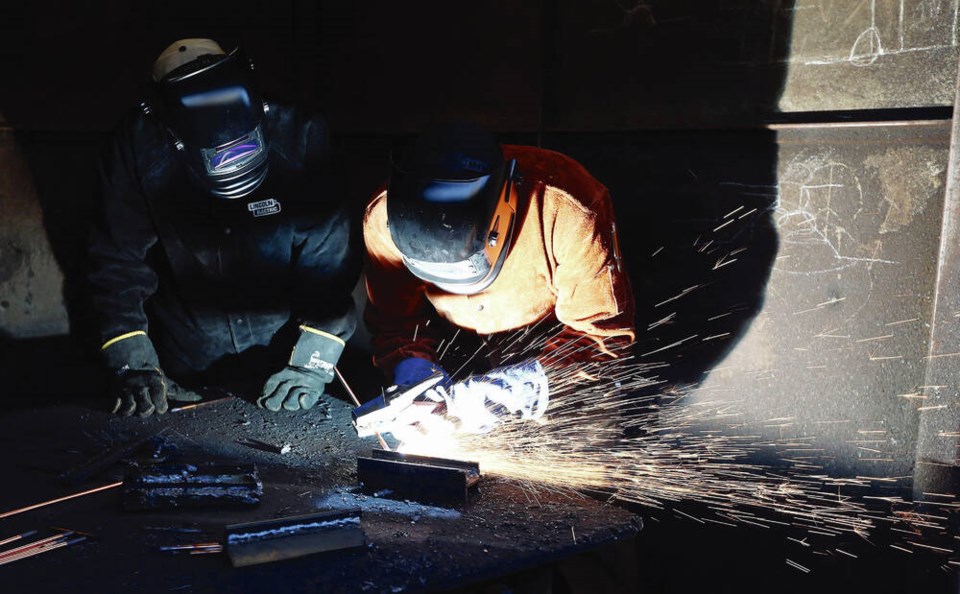Soon-to-graduate high school students are starting to think seriously about what’s next.
For many, that includes post-secondary education — within one year of high school graduation, 51% of each Grade 12 graduation class from 2001-02 to 2006-07 enrolled in B.C. public post‐secondary education.
Thanks to a study funded by the B.C. government and Canadian Apprenticeship Forum (CAF-FCA), high-school students, their parents and prospective employers can now take a closer look at the advantages of post-secondary trades apprenticeship, an alternative to academic programs.
The latter have two disadvantages: a higher first-year failure rate and a lower expectation of employment in a field related to academic preparation.
The province recently celebrated November as Apprenticeship Recognition month as a record number of people have registered as apprentices in B.C., closing a crucial skills gap, and benefiting the economy, according to Post-Secondary Education Minister Selina Robinson.
According to a report released by the Ministry of Post-Secondary Education and Future Skills, so far this year, 15,075 people in British Columbia have registered for apprenticeships, up 20% from last year.
Apprenticeship programs combine paid on-the-job training with learning in a classroom or shop setting. In most programs, students spend about 85 per cent of their time on the job.
Most programs take four years to complete. The report also emphasizes the value to the overall economy of apprenticeships.
In order to develop up-to-date data on the value of apprenticeship training to employers in B.C., CAF-FCA updated its 2006 and 2009 study across 13 skilled trades in numerous industries, including construction, manufacturing, mining, forestry, mineral and resource extraction, automotive, marine and shipbuilding services, aerospace, and tourism and hospitality.
The study was commissioned to help better understand how apprenticeship training also represents a return on investment to employers. For every dollar invested in apprenticeship training, says the report, employers received an average positive return of 36 cents. This ranged from an average positive return of 35 cents for construction trades to 43 cents for industrial trades.
For high school students who will graduate during the next two or three years, “an apprenticeship in a skilled trade is a valuable entry point to a long-lasting, good-paying career that is helping to build B.C.,” says Andrew Mercier, minister of state for workforce development. “With more than 83,000 skilled-trades jobs expected over the next decade, this is the time to begin your career in skilled trades.”
According to Mercier, technical training in more than 65 trades is offered at 15 public post-secondary institutions and non-public training providers.
SkilledTradesBC funds more than 26,000 apprenticeship and foundation training seats to train the next generation of skilled trade workers in B.C. Over the past year, SkilledTradesBC began implementing skilled-trades certification, starting with seven trades in the electrical and mechanical sectors.
Shelley Gray, CEO of SkilledTradesBC, says it’s been an “extraordinary year” with a record-breaking number of people entering the skilled trades in B.C.
Skilled-trades certification formally recognizes the skills of trades workers, gets more people to choose a career in the trades, and allows employers to access the skilled workforce they need, she said.
According to SkilledTradesBC, over the past five years, womens’ participation in under-represented trades has increased by 52%.
Over the past 10 years, Indigenous Peoples participation in trades and the apprenticeship system in B.C. has also continually increased. The number of Indigenous Peoples participating in apprenticeship training has grown from 1,700 to nearly 3,500 (a 102% increase).
Trevor Quilt, a Tsilhqot’in Nation carpentry apprentice, is quoted by SkilledTradesBC as saying: “In becoming a certified tradesman, a Red Seal carpenter, I will be able to build and renovate homes in my First Nations community and Nation.”
SkilledTradesBC Youth Trade Programs allow soon-to-graduate high school students to get started in a trade while they’re still in high school. That means they could be working in their chosen field, learning from experts and earning a paycheque — all before they graduate.
According to B.C. student outcomes data from 2020 to 2022, graduates across all trades foundation programs reported a 92% satisfaction rate, with 95% of employed respondents working full-time. Of graduates from all apprenticeship programs, 91% of employed respondents were in a job related to their program.
Geoff Johnson is a former superintendent of schools



